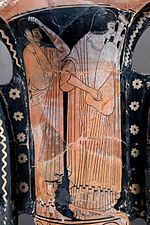Plaintiff

A woman who professionally practices the ritual lament for the dead for a fee is called a mourning woman .
There were mourners in oriental , ancient Egyptian and, more rarely, in Greek and Roman mourning customs , especially since the Hellenistic period at the burials of wealthy deceased. The lament for the dead remained generally a matter for the female relatives. There are still a few mourners in different cultures such as in Montenegro (Narikača).
definition
Ernst Götzinger defined in 1885:
“Old, in some places still existing name of the lamentation for the dead, which was generally widespread among the ancient peoples, actually cries of lamentation over the dead, then lamentation with well-composed speech and certain gestures, for which the relatives had to help. As attributes of such a lament for the dead often appear to be scuffling and beating of the chest, also tearing off the clothes. Later this tedious ceremonial process was left to ordered and paid mourners. Hildebrand in Grimm's vocabulary "
In cultural studies and psychoanalysis, this behavior is part of the area of interpassivity .
Mourners in Ancient Egypt
In ancient Egypt , mourners who accompanied the pageant in exchange for goods , later for money, at funeral ceremonies , deliberately called attention to the death of the person to be buried through loud complaints and screaming , but also through song and dance. Mourners have been documented since the Old Kingdom . Mourning women could literally be “hired”, whereby the number of mourning women could provide information about the assets of the grieving family. To the pageant they wore plain, white dresses and no jewelry. Their actions consisted of slapping their hands on their mostly bared torsos and throwing ashes at themselves. They also pulled their hair out. They not only howled, but also recited various prayers and lamentations. The litigation processions were led by priestesses , who assumed the symbolic role of Isis and Nephthys .
Userhet's tomb
literature
- Hans Bonnet : Wailing Woman . In: Lexicon of Egyptian Religious History . Nikol, Hamburg 2000, ISBN 3-937872-08-6 , pp. 376-377 .
- Elisabeth Bergmann: Daughters of Egypt - the story of women on the Nile. Grin, Munich 2007, ISBN 3-638-78252-2 , p. 14f.
- Gerhard Müller: Theological Real Encyclopedia. de Gruyter, Berlin 2002, ISBN 3-11-017388-3 , p. 5.
Individual evidence
Web links
- German Colonial Lexicon. Volume II, 1920, p. 308 plaintiffs . At: ub.bildarchiv-dkg.uni-frankfurt.de , last accessed on August 8, 2014.
- Tobias Wiethoff: Switzerland: From the gloomy train of the mourners . On: spiegel.de of April 10, 2000, last accessed on August 8, 2014.





